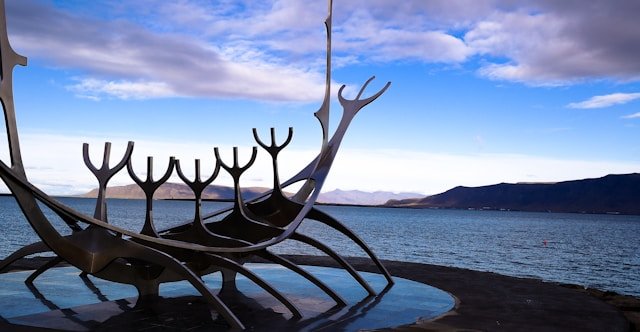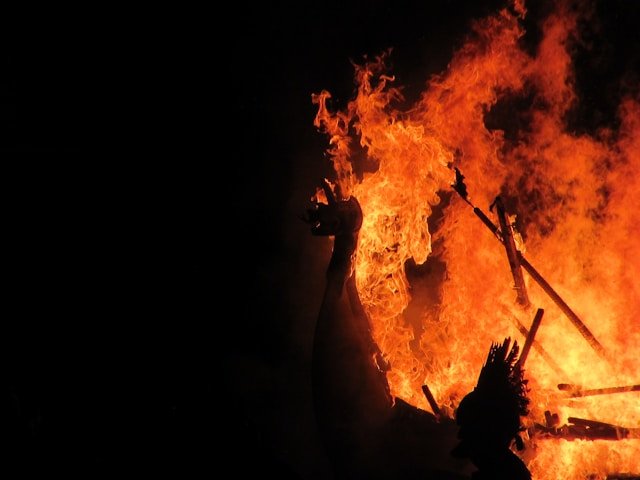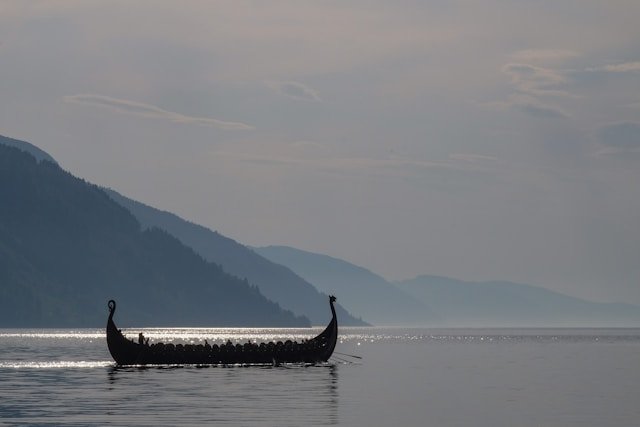The Vikings: Explorers, Warriors, Traders, and Craftsmen
Who Were the Vikings?
The Vikings were seafaring people from Scandinavia (modern-day Norway, Sweden, Denmark, and Iceland) who lived during the Viking Age, roughly from the late 8th century to the early 11th century. They are often remembered as fierce warriors, but they were also skilled shipbuilders, traders, farmers, and explorers.
Their influence stretched far beyond their homelands, reaching as far as North America, the Middle East, and Central Asia.
Though popular culture often depicts Vikings as ruthless raiders, their legacy is much broader. They established trade routes, settled new lands, and left a lasting impact on European languages, laws, and customs.

Thanks to TV series like Vikings: Valhalla and The Last Kingdom, anime such as Vinland Saga, films like The Northman, and video games like Assassin’s Creed: Valhalla, interest in Viking history is stronger than ever. But how much of what we believe about Vikings is fact, and how much is myth?
Table Of Contents
The Viking Age: A Timeline
Historians generally consider the Viking Age to have begun in 793 CE with the raid on the Lindisfarne Monastery off the coast of England. This shocking attack marked the beginning of Viking raids across Europe. Over the next few centuries, Viking explorers and warriors made their presence felt in Britain, Ireland, France, and even as far as Russia and the Byzantine Empire.
The Viking Age came to an end in 1066 CE with the Battle of Stamford Bridge, where the English army defeated the invading Norse forces of King Harald Hardrada. Shortly after, William the Conqueror, himself a descendant of Viking settlers in Normandy, took the English throne following the Battle of Hastings.
Religion and Norse Mythology
Before converting to Christianity, the Vikings followed Norse mythology, worshipping gods such as Odin, Thor, Loki, and Freyja. These deities were central to Viking culture, influencing everything from daily life to warfare and the afterlife.

- Odin, the Allfather, was the god of wisdom, war, and poetry. He ruled over Valhalla, a grand hall where fallen warriors were said to feast until the end of time.
- Thor, the thunder god, was known for his immense strength and his hammer, Mjolnir. He was the protector of gods and humans alike.
- Loki, the trickster, was both friend and foe to the gods, often causing trouble but sometimes helping them as well.
- Freyja, the goddess of love and fertility, was also associated with war and death. Half of the warriors who died in battle were said to go to her hall, Folkvangr.
As Christianity spread across Scandinavia in the 10th and 11th centuries, Viking beliefs gradually changed. However, Norse mythology and traditions remained an influence in parts of Scandinavian culture for centuries.
Read more: Norse Mythology: Gods and Goddesses
Runes: The Writing of the Vikings
Runes were the Vikings’ alphabet, derived from the Germanic “futhark” script. First appearing around 150 AD in regions like Denmark, Northern Germany, and Southern Sweden.
Initially, runes were often engraved on everyday items like coins, weapons, and buckles, typically bearing the owner’s or creator’s name. Early runes were possibly more magical than practical, used for charms or symbolic purposes.

Vikings carved these symbols into stones—known as rune stones—to record historical events. Influenced by the Roman alphabet. While runes are often associated with monumental inscriptions of great deeds or memorials, discoveries such as the Bryggen inscriptions(discovered in the 1950s) in Bergen revealed their use for everyday purposes—like personal messages, prayers, and business notes. Today, it’s understood that runic writing was more widely used by Vikings than first assumed.
Read more: The Origins, Use, and Legacy of Runes
Viking Exploration and Expansion
Viking longships were engineering marvels, allowing them to travel vast distances across open seas and navigate shallow rivers. Their explorations took them farther than many medieval European civilization:
- North America: Around the year 1000, Leif Erikson, the son of Erik the Red, reached what is now Canada—500 years before Columbus. The Norse settlement at L’Anse aux Meadows in Newfoundland is evidence of this voyage.
- Greenland and Iceland: Norse explorers settled in Iceland in the late 9th century, and Erik the Red later established colonies in Greenland.
- Western Europe: Vikings raided and settled in Britain, Ireland, and France, founding cities like Dublin and influencing the English language.
- Eastern Europe and the Middle East: Norse traders, known as Varangians, traveled along rivers into modern-day Russia, Ukraine, and beyond, reaching Constantinople (now Istanbul). Some even served as elite warriors in the Byzantine Emperor’s Varangian Guard.

Viking Society and Daily Life
Despite their reputation as fearsome warriors, most Vikings were farmers, craftsmen, and traders. Their settlements were built around longhouses, and their economy relied on agriculture, fishing, and commerce.
Roles in Viking Society:
- Jarls: The noble class, consisting of powerful chieftains and warriors.
- Karls: Free farmers, traders, and skilled workers who made up the majority of the population.
- Thralls: Slaves captured in raids or born into servitude, who performed hard labor.
Viking women had more rights than most women in medieval Europe. They could inherit property, divorce their husbands, and manage businesses in their husband’s absence. Some women, known as shieldmaidens, may have even fought in battles, though historical evidence is limited.
Common Viking Myths vs. Reality
Vikings have been the subject of many myths. Let’s separate fact from fiction:
- Vikings wore horned helmets. There is no evidence that Vikings wore horned helmets in battle. This myth comes from 19th-century artistic interpretations.
- Vikings were dirty and unkempt. In reality, Vikings were known for their hygiene. They bathed regularly (at least once a week, which was uncommon in medieval Europe) and used grooming tools like combs, razors, and tweezers.
- Vikings were only raiders. While some Vikings raided, many were peaceful traders, farmers, and settlers. Their influence extended far beyond warfare. The word Viking itself comes from the Old Norse term víkingr, which originally meant “pirate” or “raider.” Not all Norse people were Vikings, but all Vikings were Norse.
Viking Legacy
The Viking legacy is still visible today. Their influence shaped modern Europe in many ways:
- Language: Many English words, such as skull, window, and berserk, come from Old Norse.
- Place Names: Towns across Britain and Ireland—like York (Jorvik) and Dublin(Dyflin)—have Viking roots.
- Shipbuilding: Viking longships were the blueprint for later European naval designs.
- Democracy: Viking assemblies, known as “Ting,” were early forms of democratic governance where free men would gather to settle disputes and enact laws. This tradition has influenced the naming of modern law courts and parliaments in Scandinavia, with Norway’s parliament called the “Stortinget” and Denmark’s parliament called the “Folketinget”.
Legendary Viking Warriors and Kings

The Viking Age reshaped the world, leaving an enduring legacy of fearless warriors, ambitious explorers, and powerful kings. The Vikings struck swiftly, often raiding for treasure and captives, but over time, they transitioned into settlers, rulers, and conquerors. Whether embarking on short-term raids or long-term campaigns for dominance, every Viking military endeavor was led by a skilled and strategic warrior.
While some Viking figures are firmly rooted in history, others exist in a blend of fact and legend. The sagas—epic tales passed down through generations—often intertwine mythology with reality, making it difficult to separate truth from fiction. Yet, whether historical or legendary, these leaders left an indelible mark on history.
Ragnar Lothbrok (c. 9th century CE)
One of the most famous Viking warriors, Ragnar Lothbrok is both a historical enigma and a legendary hero. The sagas depict him as a fearless conqueror, a dragon slayer, and a king of Denmark and Sweden. His story is recounted in The Saga of Ragnar Lothbrok, but historians debate whether he was a real person or a composite of multiple Viking leaders. He is often linked to the Viking chieftain Reginherus, who famously raided Paris in 845 CE.
According to legend, Ragnar ignored a prophecy from his wife, Aslaug, and attempted to conquer Britain with only two ships. Captured by King Ælla of Northumbria, he met his end in a pit of venomous snakes—an execution that his sons would later avenge. Ragnar’s name continues to echo through history, cemented in popular culture by the Vikings TV series.
Bjorn Ironside (c. 9th century CE)
Bjorn Ironside, the son of Ragnar Lothbrok, was a legendary Swedish king and a formidable warrior. He led Viking raids across France, England, and the Mediterranean. Historical records such as Annales Bertiniani and Chronicon Fontanellense confirm his role as a dominant Viking leader. His daring expeditions even took him as far as the Iberian Peninsula and North Africa.
Ivar the Boneless (c. 865–870 CE)
Known for his intelligence and ruthless tactics, Ivar the Boneless was allegedly a son of Ragnar Lothbrok. His nickname suggests a condition that made his bones fragile, yet he rose to power as one of the most feared Viking warlords. He is best known for leading the Great Heathen Army that invaded England in 865 CE. According to legend, after avenging his father’s death, he founded the Viking-controlled city of York. His legacy remains as one of the most cunning and formidable Viking leaders.
Harald Hardrada (r. 1046–1066 CE)
Regarded as the last great Viking king, Harald Hardrada led a life of adventure, serving as a warrior in the Byzantine Varangian Guard before claiming the throne of Norway. He waged wars against Denmark and England, ultimately dying at the Battle of Stamford Bridge in 1066—an event that marked the end of the Viking Age. His fierce leadership and military brilliance earned him the nickname Hardrada, meaning “hard ruler.”
Eric “Bloodaxe” Haraldsson (c. 930−954 CE)
The son of Norway’s first king, Harald Fairhair, Eric Bloodaxe lived up to his name, allegedly murdering most of his brothers to secure power. A fearsome warrior, he ruled as king of Norway and later as the last Viking ruler of Northumbria.
Egil Skallagrimsson (c. 910–990 CE)
A warrior-poet of legend, Egil Skallagrimsson was as skilled with words as he was with weapons. His saga portrays him as a brutal fighter with a fiery temper but also as a poet of remarkable talent. His verses are among Scandinavia’s finest early literary works.
Rollo of Normandy (r. 911–928 CE, d. 933)
Rollo, a Viking leader who once raided France, became the founder of Normandy after striking a deal with King Charles the Simple. He pledged loyalty in exchange for land, establishing a Viking stronghold that would later produce William the Conqueror, his great-great-great-grandson.
Erik the Red (c. 950–1003 CE)
Famed for founding Greenland, Erik the Red was exiled from Iceland for murder, following in the footsteps of his father, who had been exiled from Norway for the same crime. He used his exile to explore and colonize Greenland, attracting settlers with a cleverly chosen name.
Leif Erikson (c. 970–1024 CE)
The son of Erik the Red, Leif Erikson is widely regarded as the first European to set foot in North America, nearly 500 years before Christopher Columbus. He established a short-lived Viking settlement in Vinland (modern-day Newfoundland, Canada), marking the Norse’s brief but historic presence in the New World.
Freydis Eriksdottir (c. 970–1005 CE)
A fierce and controversial figure, Freydis—daughter of Erik the Red—is remembered for her role in the Vinland sagas. One account portrays her as a courageous warrior who single-handedly defended a Viking settlement while pregnant. Another version paints her as a ruthless schemer who orchestrated murders to secure power.
Hastein (c. 9th century CE)
A legendary Viking chieftain, Hastein is said to have led daring raids alongside Bjorn Ironside. He famously used deception to enter fortified cities, feigning death and “resurrecting” to open the gates for his warriors. His exploits took him across the Mediterranean, and he later played a role in Viking campaigns against England.
Harald Fairhair (r. c. 872–932 CE)
The first king to unite Norway, Harald Fairhair swore not to cut his hair until he had conquered all of Norway. His rise to power and eventual victory made him a legendary figure in Norse history. He was the father of future Viking leaders, including Erik Bloodaxe and Haakon the Good.
Harald Bluetooth (r. 958–985 CE)
Best known for uniting Denmark and converting its people to Christianity, Harald Bluetooth played a crucial role in Viking history. His legacy endures in modern technology—Bluetooth wireless technology is named after him, symbolizing his role in communication and unification.
Sweyn Forkbeard (r. 986–1014 CE)
Sweyn Forkbeard’s religious stance remains uncertain; he may have been a rogue Christian or a staunch pagan, but he undoubtedly used the church to his advantage. After seizing the throne from his father, he consolidated Denmark’s fragile control over Norway, becoming the ruler of both kingdoms. Wary of interference from Germany and the Church in Rome, Sweyn focused on strengthening the power of the church in Britain. With the combined forces of Denmark and Norway at his command, he exerted significant influence in the region. In 1002 CE, he launched an invasion of Britain, allegedly in retaliation for the massacre of a Danish settlement.
Sweyn continued his military campaigns in Britain until 1013 CE, by which time he had vanquished all opposition. That December, he was crowned King of England. However, his reign was short-lived—he died only weeks later in February 1014 CE. His son, Harald II, initially succeeded him, holding the throne while his older brother, Cnut, consolidated power. Once Cnut had eliminated any remaining resistance, Harald abdicated in his favor.
Cnut the Great (r. 1016–1035 CE)
Cnut earned the title “the Great” due to his exceptional leadership and governance. He conquered Britain, uniting it with Denmark and Norway, and later extended his influence into Sweden. His overarching goal was to unify the diverse peoples and cultures of these territories under a single rule, and for a time, he succeeded.
Cnut implemented legal reforms in Britain, standardizing punishments across his vast territories. Like many Viking rulers of the time, his commitment to Christianity remains debatable. However, he understood the importance of maintaining good relations with the church and skillfully leveraged religious institutions to support his rule.
By the time of his death, Cnut was widely regarded as a wise and effective ruler, governing England, Denmark, Norway, and parts of Sweden. He established strong trade networks and improved the infrastructure of his realms, leaving a lasting impact on the regions he controlled.
